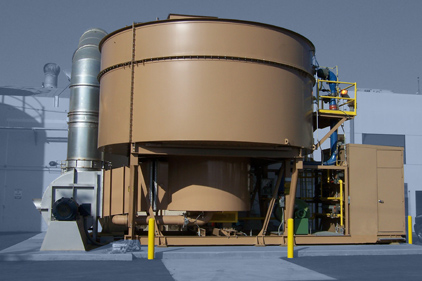TECH FLASH
Odor eater for large manufacturing plants

|
| This single rotary valve RTO was installed at a pet food manufacturing facility and completely eliminated offensive odors from reaching neighbors in the community. Source: Dürr Systems, Inc. |
When a pet food manufacturer opened its production plant in California, the company began receiving complaints from residents who lived near the facility because of a worsening odor emanating from its process exhaust. Threats of fines and sanctions from local government agencies were real possibilities.
Recognizing the need to control the emissions coming from its facility and the desire to remedy this unfortunate issue with its neighbors, the processor invested nearly $4 million to solve the problem. In addition to its investment in several odor control systems, specifically carbon canisters for adsorption and tall stack dilution, the company hired the Environmental and Energy Systems business unit of Dürr Systems, located in Plymouth, MI, to make the bad odors go away. Dürr has had past experience with not only food manufacturing applications, but specifically with pet food manufacturing facilities.
Dürr’s solution was to install its Ecopure RL single rotary valve regenerative thermal oxidizer (RTO) at the end of each of the pet food manufacturer’s new process stream ducts. The system uses zero-leakage, single-valve technology. The supplier also offered a series of guarantees concerning odor reduction as part of the system purchase. If these guarantees were not met, the supplier would be contractually liable for creating a new solution at its own expense.
While concerns about the cost of thermal oxidation technology to control the odor issue were discussed initially, Dürr designed a system to maximize fuel efficiency, specifically with the use of a proprietary heat-exchange, ceramic media block internally installed within the RTO. For some applications, the use of secondary heat recovery equipment can be seamlessly integrated at the end of the RTO to capture wasted energy to be used in other parts of the processor’s facility, according to Jim Stone, Dürr Environmental and Energy Systems, sales and proposals.
As soon as the RTO system was commissioned and started for process, people from the plant and surrounding neighborhoods began noticing an immediate and dramatic difference. Not only was there an increased reduction, there was no longer any odor at all emanating from the plant. The complaints stopped, and the threat of fines was eliminated. The odor-eating RTO systems have been in use since 2008, and there have been no reports of system downtime, says Stone.
Making RTOs more cost effective
Many technologies exist to clean up odors, including carbon or other sorbent filtration, maskants or perfumes, tall stack dilution/dispersion, chemical or bio-scrubbing, bio-filtration and RTO. RTO is an option when the other technologies don’t seem to solve the odor problem entirely, according to Stone. The issue with RTO, however, has been primarily with cost. Destroying odors with high temperatures is rarely a question of effectiveness. The use of high temperatures—typically in excess of 1,500°F—in a thermal oxidizer proves effective, but tends to be more expensive than the other methods. But the RTO can be designed to recover heat to minimize the cost of fuel, and leftover heat can be applied back to the process to conserve energy, says Stone.
Ongoing maintenance costs also pose a problem for adopting RTO technology, often involving the valve sealing system that RTOs use to direct air from chamber to chamber. However, the use of rotary diverter valve design can replace the multiple valves and actuators found on many RTOs. The result is fewer moving parts, less wear and tear, less downtime and lower maintenance costs, according to Stone.
For more information: Marta Kelly, Dürr Systems, Inc., Plymouth, MI, 734-254-2418 or visit Dürr’s website.
Looking for a reprint of this article?
From high-res PDFs to custom plaques, order your copy today!







